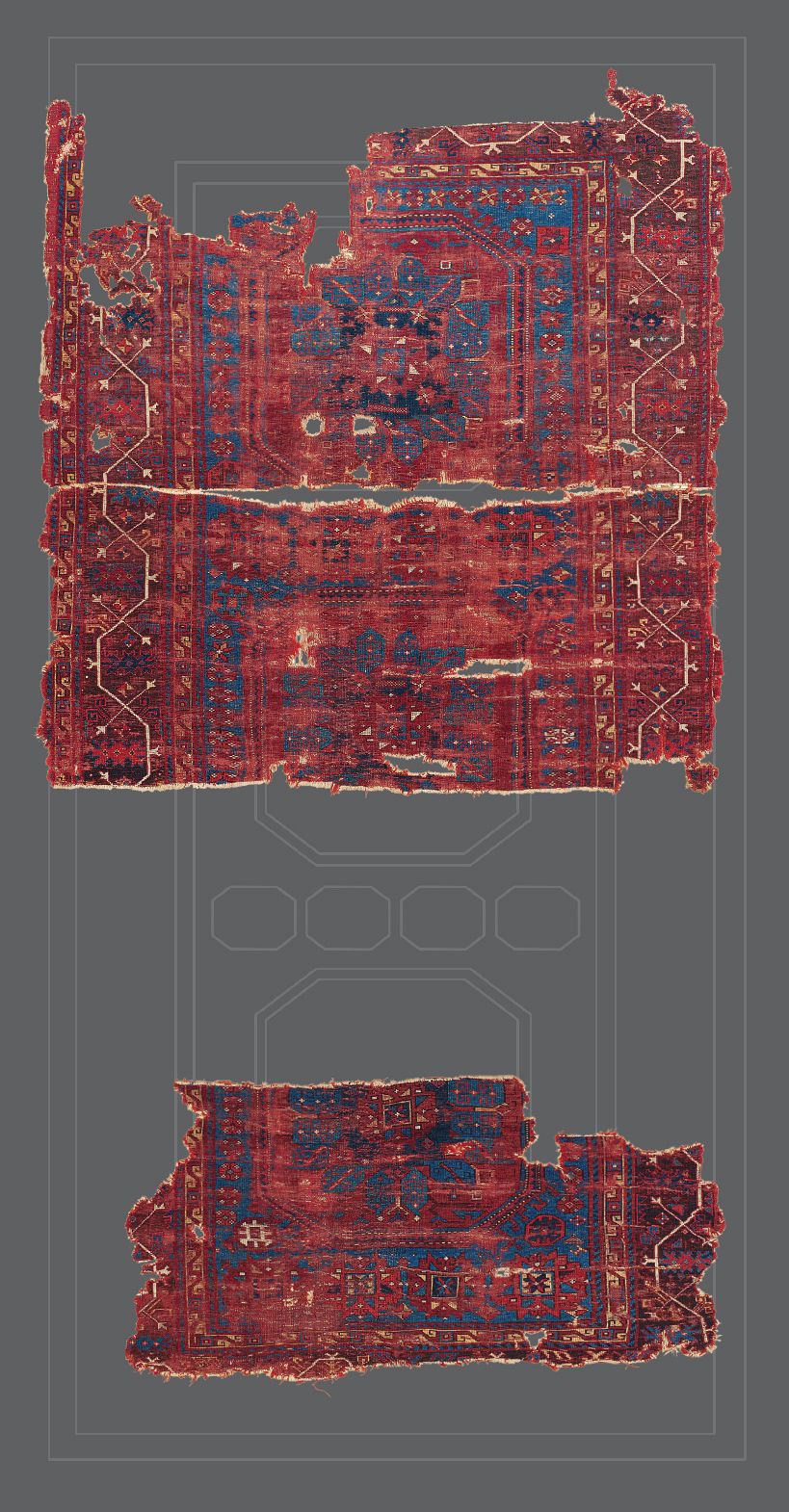Christie's LONDON
Oriental Rugs and Carpets
Tuesday 2 October 2012
VARIOUS PROPERTIES
51
A FRAGMENTARY EAST ANATOLIAN CARPET
LATE 16TH OR FIRST HALF 17TH CENTURY
Overall wear, some corroded
colours, mounted
Overall approx. 10ft.9in. x 5ft.9in. (327cm. x
175cm.);
largest panel 3ft.8in. x 5ft.9in (110cm. x 175cm.)
£40,000-60,000 US$61,000-90,000
€45,000-67,000
This rare
fragment is a fascinating and rare example of 16th-century weaving. It is
an intriguing
hybrid, combining elements of classical west Anatolian
Large Pattern Holbein carpets with a more
expressive tradition of
village weaving. The Large Pattern Holbein design is far less homogeneous
across the different examples than the Small Pattern Holbein. The octagons
are generally filled with
an outer band of “star and bar” designs
around the centre (Volkmar Gantzhorn, The Christian Oriental
Carpet,
Köln, 1991, p.188 gives eight variants) but there are variants including
examples with Crivelli-type
medallions, especially in the Spanish
versions of the design (Gantzhorn, op.cit, p.198, ill.279). The
divisions between the octagons are even more varied; they can be almost
non-existent, they can have
two large octagons, or they can be an
extension of the inner border.
The present carpet has a
particularly rare version of the octagonal medallion. It is found on one
16th
century Large Pattern Holbein carpet first published by F.R.
Martin (A History of Oriental Carpets
before 1800, Vienna, 1908, fig.
308) as being in the collection of Dr W. Bode, which was donated
by the
good doctor to the collection of the Berlin Museum of Islamic Art (BOIM
no.1.29; Gantzhorn,
op.cit, p.181). The Bode rug has the same archaic
medallion arrangement as the current example with
a wheel of spokes,
which sit separately, enclosing a series of stars divided by short bars.
Interestingly,
for an unusual variant of the design, not only did it
transfer to East Anatolia as in the present rug,
but it is also this
variant that forms the central octagonal medallion on the silk ”Ashtapada”
carpet
in the Museum of Islamic Art, Doha (Michael Franses, ’Indian
Silk Carpets’, Hali, issue 167, spring
2011, pp.80-89 esp.pl.5, p.83).
Franses illustrates a further fragment of a 15th century Indian carpet
containing a similar medallion in a 2-1-2 Large pattern Holbein design
(op.cit, pl.22, p.88).
In the present carpet while the outer band
of radiating lozenge-shaped panels containing cloud-like
motifs is
immediately recognizable, the design of the interior of the medallions has
lost the structure
seen in the earlier examples. It retains both stars
and bars, but their relationship has been lost and
they are left as
scattered small elements.
The three medallion field design crossed
by rows of smaller octagons is comparable to another
16th-century Large
Pattern Holbein carpet in the Berlin Museum of Islamic Art (BMIK no.
1.5526,
see Kurt Erdmann, Seven Hundred Years of Oriental Carpets,
London,1970, pl.VIII). That carpet
has a very similar design format and
yet it is a far more sophisticated court weaving with a complex
classical mock-kufic border. The band of four octagonal panels that
divides the main octagons has its
antecedent in a magnificent Large
Pattern Holbein carpet, again from western Anatolia, that appeared
relatively recently at auction in Italy and which was then published by
Moshe Tabibnia, although there
the smaller octagons also flank the main
panels (Jon Thompson, Milestones in the History of Carpets,
Milan,
2006, pl.1, p.35).
Two fragments in the Kirchheim Collection share
an almost identical border with the present
carpet although the field
design is very different (E. Heinrich Kirchheim et al, Orient Stars, A
Carpet
Collection, Stuttgart and London, 1993, fig. 208 and 209,
pp.330-331). Both of these fragments are
published as 15th century; the
present fragment is almost certainly later. It is a border that is also
found on a number of later carpets from various centres in Turkey, for
example a slightly derivative
17th century eastern Anatolian version
from the Ulu Mosque in Divrigi (Suzan Bayraktaroglu and Serpil
Özcelik
(eds.), Carpet Museum and Kilim and Flatweaving Rugs Museum Catalogue,
Ankara, 2007,
no.33, pp.66-67) or on a later 17th or early 18th century
prayer rug from the Ulu Mosque in Beypazari
near Ankara in central
Anatolia (Hali, issue 167, spring 2011, pl.6, p.93).
Although all
the elements of the design are from western and central Anatolia, the
colour tonality here
is most typical of an eastern Anatolian origin. A
very similar inner border design is found on rugs from
central Anatolia
(Hölya Tezcan and Sumiyo Okumura (eds.), Weaving Heritage of Anatolia 2,
Istanbul,
2007, nos.47, 72 and 87 for example). Our rug has an
interesting variant on the design normally
encountered, in that each
small square panel, instead of being plain or quartered, as in the other
examples, has a concentric square design. This seems to be the descendant
of a very early design that
is found on a 14th century rug from the Ulu
mosque in Divrigi (Bayraktaroglu and Özcelik, op.cit, no.3,
pp.6-7).
This reinforces the suggestion of an eastern Anatolian origin for the
present carpet. |

